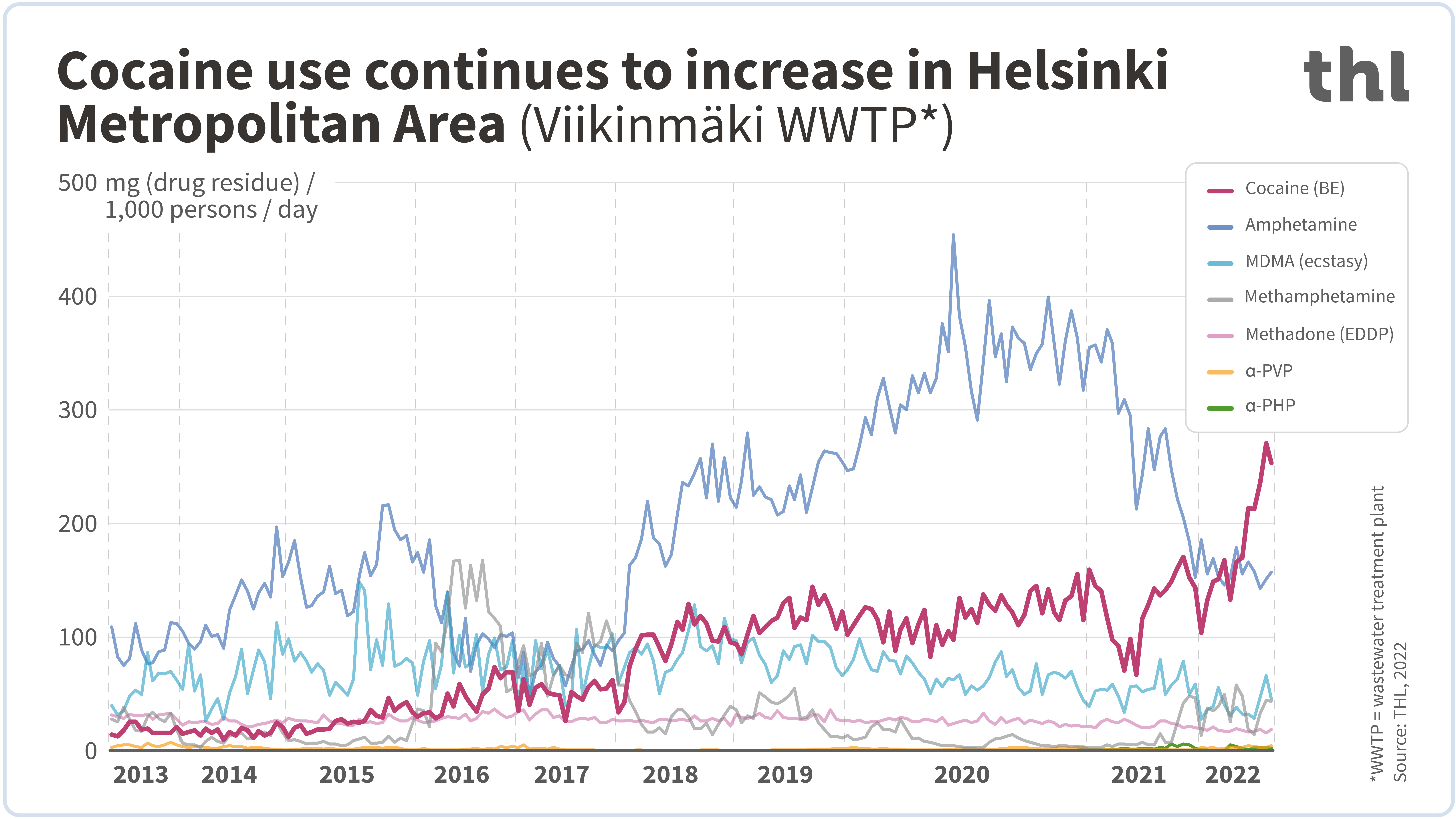THL’s wastewater study: Cocaine use continues to grow and is highly concentrated in the Helsinki Metropolitan Area
THL’s wastewater study has found that cocaine use has continued to increase in Finland and is increasingly concentrated in the Helsinki Metropolitan Area. Amphetamine, in contrast, is used throughout the country, but national usage levels have remained below the record-breaking level reached in 2020.

The results of the latest extensive national wastewater drug-content monitoring were obtained from samples taken in 27 cities and their surrounding areas. The study covers approximately 60 per cent of the Finnish population. In addition, the continuous wastewater monitoring results from Helsinki, Tampere and Turku have been published until August of this year.
The results indicate that amphetamine is still widely used throughout the country, but usage levels are lower for recent years in almost all the cities studied.
“The use of amphetamine has traditionally played a key role in the entire Finnish drug scene. However, weekend use of cocaine in the Helsinki Metropolitan Area exceeded this summer that of amphetamine for the first time ever,” reports Head of Unit Teemu Gunnar from THL.
The samples for continuous wastewater research are collected from Helsinki, Tampere and Turku between Sunday and Monday morning, so the results shed light in particular on weekend drug use.
“The decline in the use of amphetamine over the last year or more is also reflected in a lessening of other harmful social phenomena, such as the decline in the incidence of drug-impaired driving", Gunnar continues.
Compared to the previous sampling period, total drug use levels saw a clear decrease in areas such as Lahti and Mikkeli. On the other hand, drug use in the Lappeenranta region has been on an increasing trend.
“The use of amphetamine started to decline after extensive drug seizures by law enforcement authorities in spring 2021, and it has not bounced back since then to its previous, record-breaking levels. The general availability of cocaine has increased in Europe, however, and this most likely has an impact on the Finnish situation. However, there is no clear picture yet as to why cocaine use is so strongly concentrated in the Helsinki Metropolitan Area,” Gunnar explains.
Results of wastewater drug monitoring
- Monitoring at 27 wastewater treatment plantsFile opens in a new tab pdf 54kB (in Finnish, pdf, 55 KB)
- Continuous monitoring at Viikinmäki, Helsinki (png, 1055 KB)
- Continuous monitoring at Viinikanlahti, Tampere (png, 664 KB)
- Continuous monitoring at Kakolanmäki, Turku (png, 687 KB)
Cocaine use increasing in the Helsinki Metropolitan Area – usage levels lower in Northern Finland
The use of cocaine has continued to grow rapidly, especially in the Helsinki Metropolitan Area. It is also widely used in Lahti and other cities in southern Finland. To the north of Tampere, however, usage levels are mostly lower.
“In terms of cocaine use, there is a clear divide between different regions of Finland. Use of cocaine in the Helsinki Metropolitan Area is abundant and growing, but in northern cities cocaine use is still very low compared to amphetamine,” explains THL Development Manager Aino Kankaanpää.
“In addition to the metropolitan area, the wastewater samples also showed a significant increase in cocaine use in the regions of Salo and Kuopio. These levels are still considerably lower than those of the Helsinki Metropolitan Area,” Kankaanpää adds.
The increased prevalence of cocaine is also reflected in police and Finnish Customs statistics on areas such as drug seizures.
Decrease in ecstasy use
MDMA, commonly known as Ecstasy, is used everywhere in Finland, but its use has also decreased in many of the cities examined, including Jyväskylä, Lahti and Pori.
Methamphetamine use is currently very low in Finland, although it has increased somewhat in some of the cities studied. The use of methamphetamine has fallen considerably since 2016 and 2017, when it temporarily exceeded even amphetamine usage levels in the Helsinki Metropolitan Area.
Designer drugs are regularly detected in the metropolitan area and occasionally in other parts of the country
The most common designer drugs associated with problem use in Finland, such as the synthetic cathinones alpha-PVP and alpha-PHP, were regularly detected only in the Helsinki Metropolitan Area and its vicinity, at the Nummela treatment plant in Vihti.
In March, alpha-PHP was also detected in Kokkola, Vaasa, Seinäjoki, Pietarsaari and Savonlinna. The levels recorded in these cities were higher than in the metropolitan area.
The wastewater study indicates that regional and temporal fluctuations in use are clearly higher for designer drugs than for traditional drugs.
Further information:
Read more about wastewater studies on drug use (in Finnish)
Teemu Gunnar
Head of Unit
Finnish Institute for Health and Welfare
tel. +358 29 524 8425
firstname.lastname@thl.fi
Aino Kankaanpää
Development Manager
Finnish Institute for Health and Welfare
tel. +358 29 524 8427
firstname.lastname@thl.fi



